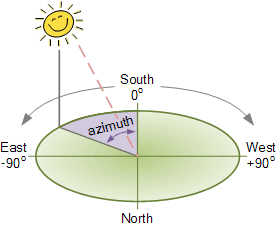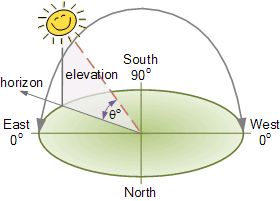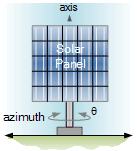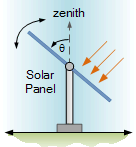Solar Panel Orientation
Solar Panel Orientation and Positioning
![]() Here in this tutorial we will discuss solar panel orientation and positioning. Photovoltaic solar power offers many advantages in the generation of electricity. It has zero raw fuel costs, unlimited supply and no environmental issues such as transport, storage, or pollution. Solar power is available everywhere, even on the moon.
Here in this tutorial we will discuss solar panel orientation and positioning. Photovoltaic solar power offers many advantages in the generation of electricity. It has zero raw fuel costs, unlimited supply and no environmental issues such as transport, storage, or pollution. Solar power is available everywhere, even on the moon.
So do solar panels have to have direct sunlight. Well yes if we want to get the most out of our newly installed solar photovoltaic system as it makes no sense in installing them in dark or shaded locations.
Solar panel orientation points or “orientates” a panel or an array directly at the suns radiant energy. This is because as we know, the more surface area that is exposed to direct sunlight, the more output the photovoltaic panel will produce. But here lies the problem.
While the photovoltaic solar panel may be perfectly aligned to receive the suns energy, it is a stationary object being fixed to either a roof or mounted directly onto a frame. With regards to a solar panel, the sun however is not in a stationary position and is constantly changing its position in the sky relative to the earth from morning through to night making the correct solar panel orientation difficult.
So the challenge in getting the maximum benefit of collecting solar power is to ensure that a photovoltaic solar panel or a complete PV array, is correctly orientated and positioned with regards to the direct sunlight coming from the sun at all times of the day. As well as the “solar panel orientation”, the number of hours of sunlight a day the solar panel receives as well as the intensity or brightness of the sunlight are also important.
For example, when the sun is lower in the sky during the winter months the solar panels orientation needs to be more vertical as the solar radiation passes through more atmosphere to reach the solar panel and therefore its intensity is reduced by the scattering and absorption effect of atmosphere and clouds.
In the summer months when the sun is brighter and higher in the sky the solar radiation is more direct and therefore stronger as it has less distance to travel through the Earth’s atmosphere so the solar panel orientation is more horizontal.
Solar Panel Orientation of Azimuth and Zenith
Solar PV modules and panels work best when their absorbing surface is perpendicular to the suns incoming rays. The position of the sun in the sky can be plotted using two angles, azimuth and zenith and the angle of the solar panel orientation relies upon these two values.
Solar Panel Orientation – Azimuth Orientation

Azimuth – This is the compass angle of the sun as it moves through the sky from East to West over the course of the day. Generally, azimuth is calculated as an angle from true south.
At solar noon which is defined as an azimuth angle of zero degrees, therefore Azimuth = 0o, the sun will be directly south in the northern hemisphere and directly north in the southern hemisphere.
Solar azimuth angles to the east of due south are negative in nature, with due east having an azimuth angle of -90o. Solar azimuth angles to the west of due south are positive in nature, with due west having an azimuth angle of +90o. In general however, the azimuth angle required for the correct solar panel orientation varies with the latitude and time of year.
Solar Panel Orientation – Zenith Orientation

Zenith – This is the angle of the sun looking up from ground level or the horizon. The zenith angle of the sun varies throughout the day in the form of an arc with the sun reaching its maximum elevation (also called solar altitude) around midday. The suns elevation is defined as 0o at sunrise and sunset, and 90o at midday when the sun is directly overhead.
However, the elevation of the sun at midday is different between the summer solstice and the winter solstice representing the longest and shortest days of the year as the suns path forms an arc across the sky representing either spring or autumn.
The solar elevation and azimuth over the period of a full year can be plotted onto a solar chart. A sun chart enables you to locate the position of the sun at any time of the day, during any month and for any location making solar panel orientation much easier.
Pre-made sun charts or sun path diagrams, can be purchased, downloaded from the internet or constructed using graph paper for any location on the earth surface using the same principal as the sun dial in the garden.
On a sun chart the zenith scale is generally represented as a series of concentric circles spreading out vertically from left to right, while the azimuth scale is set around the perimeter of the chart. The azimuth angle is read by setting a straight edge from the center of the chart to the intersection of the required hour and date path lines and noting where it cuts the charts perimeter. Different charts are required for different locations.
In Northern Europe, at a latitude of about 50o North, (London) the sun’s path is 262o wide at the summer solstice and the maximum solar zenith (elevation) is 62o. At the winter solstice, the sun’s path is only 104o wide with the maximum solar zenith reducing to about 15o.
Likewise in Southern Europe, at a latitude of 40o North (Spain), the sun’s path is 245o wide at the summer solstice and the maximum solar zenith is 72o. At the winter solstice, the suns path is 120o wide and the maximum solar zenith is 25o. (Data kindly supplied by: Timeanddate.com).
Solar Panel Orientation and Tilt
So we can see that as well as moving across the sky (solar azimuth), the sun also moves up and down (solar zenith) throughout the year making it difficult to provide a fixed solar panel orientation. Then for maximum conversion of sunlight into solar electricity, solar panels need to be mounted at an angle for them to point directly at the sun.
Depending upon how the panel is mounted, it may be kept at a permanent angle, or adjusted throughout the year to take full advantage of the suns solar energy. Adjustment of a static mounted photovoltaic solar system can result in 10% to 40% more power output yearly making a considerable difference to the charging time for batteries.
Solar Panel Orientation
Solar Panel Orientation refers to our azimuth setting. Most of the energy coming from the sun arrives in straight line. A solar panel or solar array will capture more energy if it is facing directly at the sun, perpendicular to the straight line between the position of the panels installation and the sun.

Then we need to have the solar panel turned towards the terrestrial equator (either facing south in the northern hemisphere, or north in the southern hemisphere) so that during the day its orientation allows the panel to catch the greatest possible amount of solar radiation possible.
There are different ways of achieving the required solar panel orientation. We could just point the PV panel or array due south or north using a compass, find the central angle between the summer and winter azimuth settings or more accurately position the panels relative to the central solar noon.
The solar noon refers to the highest position of the sun within the sky as it arcs across from east to west. Solar noon is different to 12:00 o’clock noon or midday as a measurement of time. Generally the solar noon occurs between 12:00 o’clock and 14:00 o’clock depending upon the location.
It is very important when positioning and aligning a solar panel or array that no part of a solar panel or solar array are ever shaded from the sun as we need 100% solar radiation across the panel. Check that the elements that surround the panel or array (trees, buildings, walls, other panels, etc.) to be sure that they will not cast a shadow on the panels at any time of the day or year.
Solar Panel Tilt
Solar Panel Tilt refers to our zenith or elevation setting. Once the best azimuth position is found, the next parameter that is key to producing the most solar electricity is the elevation of the PV panel. We saw from our data example above for London, that the maximum height that the sun reaches every day varies, with the maximum angle of the sun on the day of the summer solstice being about 62o and the minimum angle for the winter solstice about 15o.

For a fixed solar installation, it is preferred that the PV panels are installed with a centralised tilt angle representing the vernal equinox, or the autumnal equinox, and in our example data above this would be about 38 degrees (38o).
However, this tilt orientation is not as critical with regards to the solar panels orientation as even at a tilt angle of nearly 45 degrees (45o) with respect to the suns solar rays will still receives more than 75 percent as much energy per unit surface area as it does when it is optimally aligned.
Then a misalignment of up to 15o either positive or negative makes very little difference to a photovoltaic panels output. Ideally, solar panels should be located where they will receive as much sunlight as possible, averaged out during the course of the day and the course of the year.
The solar panel orientation and tilt of a fixed solar PV panel or array can also be optimised for a particular month or season during the year. For example, a solar power system might be designed to produce maximum power output only in the winter months in order to reduce peak electricity costs thus, the system should be installed so that the optimum solar panel orientation and tilt occurs for the maximum winter power output.
One of the most popular fixed solar power systems involves mounting a PV panel, or a set of PV panels, directly onto a steeply pitched roof that faces toward due south (or north) allowing for very little adjustment of both the solar panel orientation and tilt although most mounting brackets and support frames do allow for some small adjustments. Maximising the power output from a home solar power system is desirable to both increase the solar panels efficiency and reduce the payback time.
But in order to maximise the power output from the solar panels, we need to keep the panels perfectly aligned with the sun. As such, a means of tracking the sun across the sky is required and a PV panel or PV array with tracking ability will yearly produce about 25 to 30% more power than one mounted on a roof in a fixed position. Also solar tracking can reduce the number of PV panels required by increasing the conversion efficiency.
Solar Tracker
Tracking the position of the sun in order to expose a solar panel to maximum radiation at any given time is the main purpose of a solar tracking PV system giving the best solar panel orientation at all times of the day.
A solar tracking system can track the movement of the sun across the sky from sunrise to sunset creating optimal power output for a longer period and can also accommodate for seasonal changes of the sun direction.
The ideal solar tracking arrangement for a solar panel would be a motor-driven equatorial mount, similar to those used with sophisticated telescopes or satellite dishes. This would allow the PV panel to follow the suns rotational path all day, every day of the year giving it the best solar panel orientation and generating the maximum possible output power.
However, such large motorised tracking systems are impractical for most people, and the cost would be prohibitive for large panels or multi panel arrays. Also, solar trackers cannot be used on a roof installation as they need to be mounted on the ground and have sufficient space around the panel in order for it to rotate. The next best thing is a mount with a single bearing that allows for the panel to be manually orientated and tilted throughout the day if required.
Commercially available solar trackers include single-axis tracking which tracks the sun across the sky during each day at a fixed constant tilt angle. This increases the solar radiation received by up to 25-30% compared to no tracking.
Twin or dual-axis tracking, tracks the sun across the sky during each day but also adjusts the tilt angle of the array more in winter and less in summer to accurately locate the position of the sun in the sky. Dual-axis tracking increase the solar radiation received by up to 33-38% compared to no tracking. Sunnier locations benefit more from dual-axis tracking.
Photovoltaic Solar Panels can the be used as single panels on a buildings roof or walls pointing directly due south or west depending upon their location. While this type of solar panel orientation works fine for most domestic applications, in order to increase efficiency and reduce your payback period. The photovoltaic panel needs to produce the maximum amount of solar energy for the maximum amount of time during sunlight hours.
While not cheap or viable for small PV panel installations, solar trackers can be used for this purpose. Their ability to follow the sun’s path across the sky allowing your solar photovoltaic panels to absorb more sunlight, can often benefit with a reduction in the number of PV solar panels required. Offsetting the trackers initial upfront costs.
In the next tutorial about “Solar Power”, we will look at connecting solar panels together to produce larger Solar Arrays with higher voltages and currents which can then be used to build a typical solar power system.










Interesting. Zenith changes 24 degrees over the course of the year no matter where you are, so splitting the difference on panel orientation makes sense, but azimuth is 180 year round at the equator, and 0 in winter and 360 in summer. So as a rule of thumb at what latitude does solar only make sense with a tracker and at what latitude is it become impractical as a year round power supply? If this is covered later, please just respond wait!
Interesting and very useful to learn more about this topic.
Since the Earth’s axis is tilted 22.5 degrees, it would seem that the sun’s highest point in the summer would be Latitude + 22.5 degrees and the highest point in the winter would be Latitude – 22.5 degrees. Why is this not correct?
No, the declination angle of the northern hemisphere varies between +/- 23.5 degrees throughout the year. Solar noon occurs when the sun is at its highest point above our heads and does not cast any shadow on vertical objects. That is, the latitude of the sun’s rays are perpendicular and 90o vertically above the earths surface at 0o zenith. Thus the sun’s highest point during summer and lowest point during winter is determined by the tilt of the Earth’s axis and its position in its orbit around the sun, not directly related to a specific latitude.
Thanks for the new innovations that you are hinting.Please continue with the same .Avail us also with these new products.
Thanks
I’m convinced that solar power (renewable energy) is the way of the future.. Its going to put an end to the big oil companies that our feet over the fire..
I really didn’t think that I would enjoy or understand any of this before I signed up,but so far I’m finding this course to be interesting and Ive and in I think I get..
Thank you for sharing, very interesting and in a very easy to understand way.
Thanks, will keep reading.
Great article, thank you! Could you advise what device (engineering equipment) would work best to find the azimuth so we can precisely position/orient the solar panels relative to the cardinal points?
You can determine an azimuth using a good old Protractor
Do you mind if I quote a couple of your articles as long as I provide credit and sources back to your website?
My blog site is in the exact same area of interest as yours and my users would certainly benefit from a lot of the information you provide here. Please let me know if this ok with you. Thanks a lot!
The website of the link you have provided does not exist.
It was interesting when you talked about how solar panel tilt and orientation can be optimized differently during each season of the year. My brother and his wife told me they want to have a solar panel system installed for their home so they can get off the grid and start doing their part for the environment. I’ll pass along your tips to help them get the most possible value from investing in a solar energy system!
As a general rule, I have found that year round best average panel zenith is the latitude of where you live when measured from the horizontal plane. For example 56 degrees from Horizontal in parts of the UK. Using the guide in this text, when measuring the angle from vertical, then you would subtract the latitude from 90, in the case of the UK example, this would result in 38 degrees.
In the northern hemisphere, fixed panels are best situated facing due south, conversely in the southern hemisphere facing due north.
For proper site selection of solar plant, you need to take help from engineer which are trained under this field and having professional skills to select site as solar site selection plays a vital role in consuming of power supply.
Please check your Solar diodes are do work or not.
Very good written article. It will be supportive to anyone who utilizes it, including me. Keep doing
Very informative article, Thank you for assisting us like this. Keep sharing such things and helping us. Your article is really helpful for me and hopes for others too.
Hello i am Salman from Pakistan, i just want to know that if i have 3 different solar project which are nearly about to equal capacity, and if i get two plants are on its peak power, but one of them is on low than other two, so can anybody help me to tell me some reason why this happen and why my third plant have low power than other two
Heating perameter set
Hi,
I am from Mumbai, India.
Do you have any ready made charts or stencils for adjusting focal point of mirror faced dish/parabola, over a fixed pan base.?
I am looking for a ready made table, prepared based on Easting and Northing, which will give me angles, according to which i can adjust my dish with respect to north, taken from compass joined to dish.
Thanks
Aatish Chavan
Equinox means day and night are equal.Your artcle does defer.Please look and correct
Yeah, thanks.
having a hard time with the information when it starts with the sun moving, and continues to state that the sun is moving.
Obviously we all know that the Earth revolves around the sun, but from a fixed photovoltaic solar panels point of view here on the Earth, it appears that the sun is moving across the sky which is why the tutorial explains about the need for tracking the sun throughout the day for maximum exposure. Apologies if you found it confusing.
Dear Sir, Is it not true that in Southern New Jersey, fixed solar panels should be facing South? Also, with fixed solar panels facing South, wouldn’t that give you the best year round exposure to solar radiation?
In the Northern Hemisphere, in my case Southern New Jersey, wouldn’t fixed solar panels facing West be a bad idea for optimizing the benefits of having sola?
Hello Tom, I do not mention Southern New Jersey? In the northern hemisphere you look south, and down to the equator to see the sun. In the southern hemisphere you look north, and up to the equator to see the sun. Then any solar panels should be aligned accordingly for maximum exposure.
Because Southern New Jersey, in fact, ALL of New Jersey is in the Northern Hemisphere, I will take that as a yes, that fixed solar panels should be facing South.
Thank you for the feed back..
Hey, thanks for the post.Really looking forward to read more. Will read on…